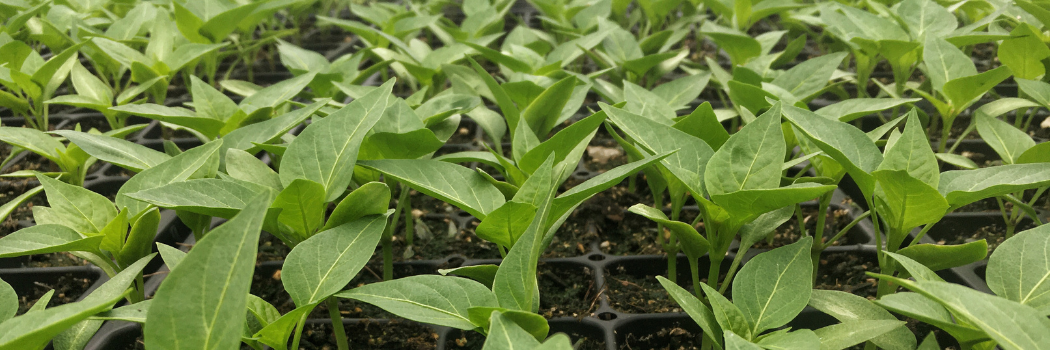- Sweet Bell Peppers | Variety Comparison Chart (PDF)
- Peppers | Key Growing Information
- Corno di Toro and Cornito Sweet Peppers Bred by Johnny's
- 'Sprinter' Red Bell Pepper Variety From Johnny's
- Video: Growing Peppers in Containers with Niki Jabbour & Johnny's
- Pepper Picks: Bells & Jalapeños | Johnny's Webinar Series
- Video: How to Grow Peppers • From Seed to Harvest
- Restoration of OP 'Hungarian Hot Wax' Pepper | Exclusively from Johnny's Selected Seeds
- Pepper Picks: Bells & Jalapeños | Johnny's Webinar Series
- 'Olly' Early-Yielding Red Bell Pepper Variety From Johnny's
- Video: Peppers: Mostly Sweet with a Touch of Heat | Johnny's Webinar Series
- 'Lilo' Purple Bell Pepper Variety From Johnny's
- 'Carmen' Corno di Toro Sweet Pepper in the Greenhouse
- Field-Grown Pepper Production Guide | Tech Sheet (PDF)
- Greenhouse Bell Pepper Production Guide | Tech Sheet (PDF)
- Greenhouse Peppers | Key Growing Information
- Video: Hand-Pollinating Peppers at Our Research Farm | Classical Plant Breeding at Johnny's Selected Seeds
- Late-Summer Recipe Preview with Farmer-Chef Frank Giglio | Three Lily Farm, Thorndike, Maine
- Johnny's Corno di Toro Peppers Rule | Press Release
- Peppers: Mostly Sweet with a Touch of Heat | Johnny's Educational Webinar Resources
- 'Brocanto' Yellow Bell Pepper Variety From Johnny's
- Jalapeño Pepper Varieties From Johnny's
- Johnny's Hot Pepper Palooza | 10 Types of Chili Peppers to Bring the Heat to Your Harvest
- How to Grow Great Pepper Seedlings | Tips for Successful Transplants
- Basket-weave Trellising Instructions for Tomato & Pepper Plants | Tech Sheet (PDF)
- 'Milena' Orange Bell Pepper Variety From Johnny's
- 'Paisan' Organic Pepperoncini Bred by Johnny's
- Johnny’s OP Stewardship Project: Restoration of ‘Hungarian Hot Wax’ Pepper
Growing Tips for Successful Pepper Seedlings
Diverse & Profitable Peppers
For many growers, peppers are among the most strikingly diverse and profitable of vegetable crops. Peppers encompass dozens of types, in many colors, shapes, and flavors that run the gamut from sweet bells to pungent habanero.
Along with diversity, peppers have versatility: harvest them green or let them ripen to their mature color—providing you with a longer harvest window as well as the opportunity for stunning multicolor market displays. You can market them fresh, dried (bagged or in ristras), pickled, and, with the proper equipment, roasted. You can price them by the piece or sell the lunchbox types in containers or bagged. You may even tap into entirely new markets by growing hot or sweet specialty peppers used in ethnic cuisines.
To take full advantage of all the pepper possibilities, you have to grow your own transplants. Pepper seedlings are not hard to start, but they are somewhat picky. And because yield can be affected by the quality of the transplants, you will want to pay special attention to your young pepper plants' needs.
Here are some tips for getting your pepper seedlings off to a healthy start.
Scheduling Your Pepper Plants
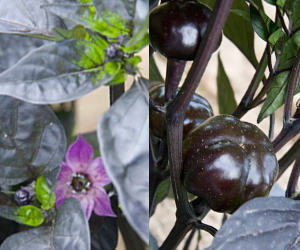
Timing is everything with peppers because they perform best within an approximately 30-degree temperature range. They are a warm-season fruiting crop, like tomatoes and eggplants, and will not thrive when temperatures are below 60°F (16°C). At the high end of their range, very little fruit set occurs above 90°F (32°C), especially with bell peppers. Some hot peppers are more heat-tolerant.
The best scenario is to get peppers transplanted as soon as the weather is warm and settled, so that fruit set occurs when temperatures are between 65°F (18°C) and 85°F (29.4°C).
Of course, weather is beyond a grower's control, and the ideal conditions may not occur in some locations and some years. When high temperatures arrive earlier than usual, for example, they can disrupt the timing and size of the harvest. In such cases, early yield may be reduced but the plants will continue growing vegetatively until conditions are right to resume fruit set.
Seeding Flats & Germination Temperature for Peppers
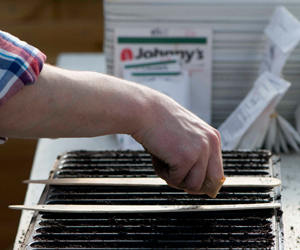
Sow seeds 8 weeks prior to transplanting. Pepper seeds should be sown ¼" deep in a fine-textured seed-starting mix or vermiculite to provide good drainage. We recommend using a 20-row seed flat; the shallow channels in the flat allow you to minimize the amount of growing medium needed while maximizing the number of seeds you can start on a heat mat. The channels also provide a convenient way to grow multiple varieties and keep them separate. (After all, advantages of starting your own seedlings include choosing exactly the varieties you are interested in and growing the number of each that you desire.)
Bottom heat of 80–90°F (27–32°C) is essential for pepper germination. Seeds will germinate in 7–8 days at that temperature. At lower temps, germination is slower and erratic, and percentage germination is reduced.
Light Quality & Cell Size at Potting Up
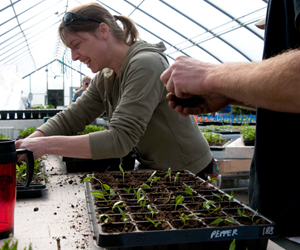
Once germinated, pepper seedlings need light—ample, full-spectrum wavelength light. At many latitudes at the seedling-starting time of the year, window light is insufficient, and some grow lights are inadequate to the task as well. See our Guide to Choosing a Grow Light for information on light quality and choosing a unit suited to your needs.
About 2 weeks after germination, when the first true leaves begin to form, carefully separate the seedlings and transplant them into cell trays or pots.
Choosing the correct cell size for peppers involves another balancing act: On the one hand, you want the pepper seedling's roots to fill the cell so that the root ball holds together when you transplant it outside. On the other, you don't want the plants to become rootbound, especially if poor weather delays planting. An oversized, rootbound transplant will be significantly stressed and result in a compromised crop. You also have to make the most of your greenhouse or other indoor protected growing space, so you don't want to grow your transplants to an unnecessarily large size.
On average, a 50-cell or 72-cell tray is a good choice for pepper seedlings that will be grown for 8–10 weeks before being transplanted.
Pepper Seedling Watering, Fertilizing & Disease Prevention
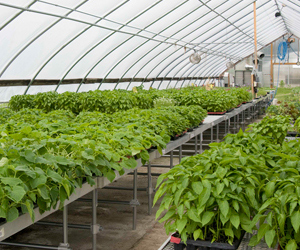
Once the seedlings have been transplanted to the cell trays, grow them at 70°F (21°C) days and 60°F (16°C) nights. Use a well-drained growing medium in the cells, and take care not to overwater the seedlings; wait until the soil is dry before watering again. Water once or twice a week with a fertilizer solution diluted to 100 ppm.
Plants also can be watered with RootShield®, an OMRI-listed product containing a beneficial fungus that helps protect roots against damaging, soilborne fungal diseases such as Pythium and Fusarium.
Hardening Off Your Pepper Seedlings
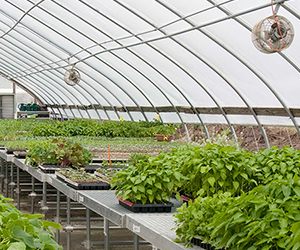
When the seedlings are about 7–8 weeks old, they should be 6–8" tall.
Ideally, they will have some buds but no open flowers.
Harden off the plants by decreasing the day temperature to 60–65°F (16–18°C) for 1 week before transplanting.
Transplanting Your Peppers
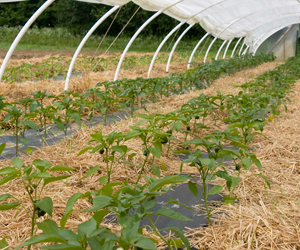
Peppers perform best in well-drained, fertile soils with a pH of 6.5. Abundant levels of phosphorus and calcium will result in better yields.
When the weather has settled and the threat of frost has passed, the peppers can be transplanted into the field or hoophouse or greenhouse.
Bury them a bit deeper than the root ball to encourage additional root growth that will make them sturdier.
Plastic mulch and row cover can be used to increase warmth and hence, earliness and yield. You can use hoops to float the row cover above and prevent it from rubbing across the plants' tender growing tips.
Peppers have perfect flowers, meaning each flower has both male and female parts and the plants can self-pollinate. Bees and other pollinators are not absolutely necessary for fertilization and fruit production.
Learn More
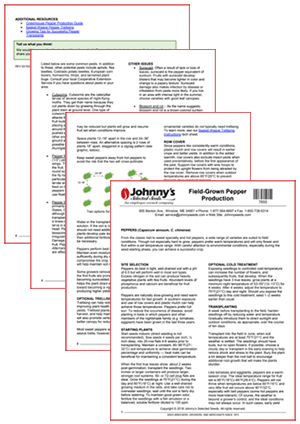
Follow the tips outlined above for pepper seedling success. With well-grown transplants and help from benign summer weather, you may find that peppers are a profitable crop for your farm.
For more essentials on pepper culture, see:
- Peppers • Key Growing Information
- Greenhouse Peppers • Key Growing Information
- Field-Grown Pepper Production Guide • Tech Sheet (PDF)
- Greenhouse Bell Pepper Production Guide • Tech Sheet (PDF)
- Visit our Pepper Library to browse all our pepper-growing information!


